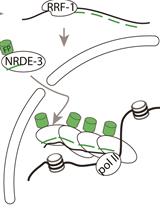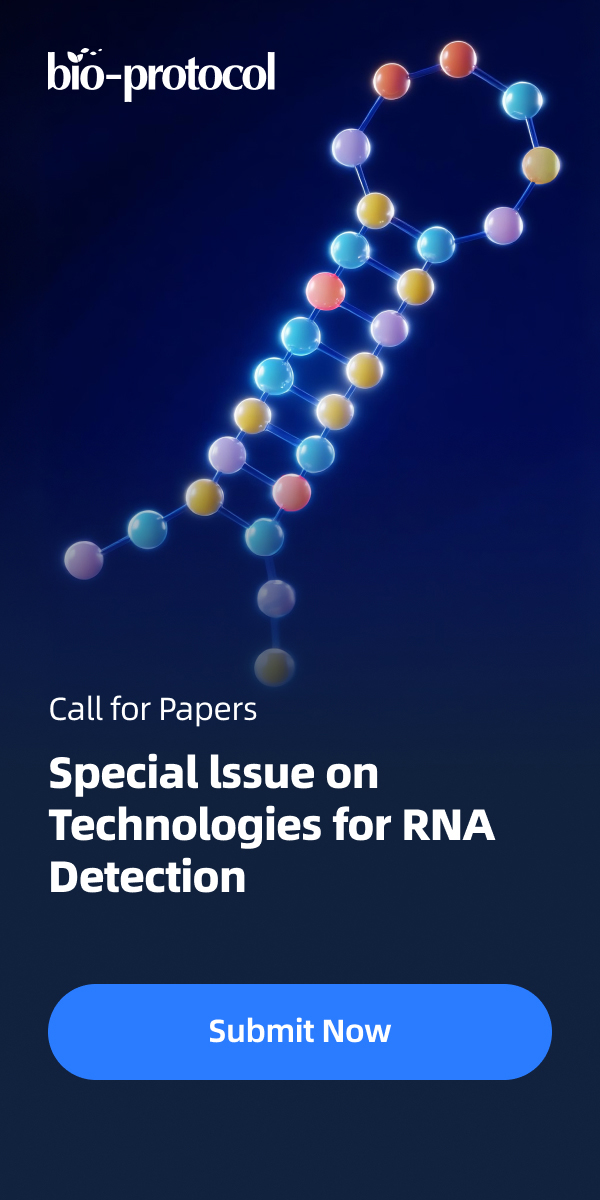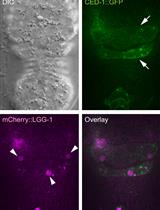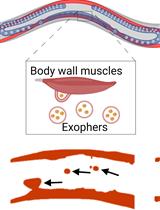- EN - English
- CN - 中文
Imaging the Pharynx to Measure the Uptake of Doxorubicin in Caenorhabditis elegans
咽部成像测定秀丽隐杆线虫中多柔比星的摄取
发布: 2017年05月20日第7卷第10期 DOI: 10.21769/BioProtoc.2291 浏览次数: 8569
评审: Neelanjan BoseKanika GeraJianwei Sun

相关实验方案

用Argonaute NRDE-3标记活性转录位点—图像秀丽隐杆线虫体内的活性转录位点
Antoine Barrière and Vincent Bertrand
2022年06月05日 2635 阅读
Abstract
Caenorhabditis elegans offers an array of advantages to investigate the roles of uptake transporters. Herein, an epifluorescent microscopy approach was developed to monitor the uptake of the autofluorescent anticancer drug, doxorubicin, into the pharynx of C. elegans by organic cation transporters.
Keywords: C. elegans (秀丽隐杆线虫)Background
Human cells have over 450 solute carrier transporters that are believed to facilitate the uptake of several ions, nutrients, as well as both therapeutic and anticancer drugs (Cesar-Razquin et al., 2015). However, the roles and substrates of a large number of these uptake transporters are not known. C. elegans is an inexpensive model organism that offers a multitude of advantages over mammalian cells to rapidly study many biological processes that are highly conserved in nature. During the last decade, this organism has been instrumental in several drug discovery programs to identify novel small molecules, e.g., those that act as antimicrobials and inhibit oxidative stress, although the yield of bioactive compounds has been less striking (Burns et al., 2010; O’Reilly et al., 2014). We reason that the recovery rate could be higher if there is greater and selective influx of the molecules by uptake transporters into the animal cells. To date, only three studies have been performed to understand the roles of uptake transporters in C. elegans (Wu et al., 1999; Cheah et al., 2013; Papaluca and Ramotar, 2016). Thus, characterization of the function and substrate specificities of uptake transporters in this organism will be advantageous towards improving the strategies employed to identify novel bioactive molecules. Herein, we outline a method to monitor uptake of the anticancer drug doxorubicin into the pharynx of C. elegans (Papaluca and Ramotar, 2016). Doxorubicin autofluorescence can be readily monitored by several widely available detection systems such as the epifluorescent microscope. We note that several benefits can be derived from this approach including a hunt for novel therapeutic substrates of the transporter by competing for doxorubicin uptake.
Materials and Reagents
- Petri dish 60 x 15 mm (SARSTEDT, catalog number: 82.1194.500 )
- 15 ml conical tube
- Frosted microscope slides (size: 1 x 3” ; thickness: 1-2 mm) (UltiDent Scientific, catalog number: 170-7107A )
- Microscope cover glass (size: 22 x 22 #1.5) (Fisher Scientific, catalog number: 12-541B )
- Platinum wire (Thomas Scientific, catalog number: 1233S71 )
- Pasteur pipet (Fisher Scientific, catalog number: 13-678-20C )
- E. coli bacteria HT115DE3 with the plasmid pL4440-empty vector
- E. coli bacteria HT115DE3 with the plasmid pL4440-oct-1 (Ahringer’s collection). Sequence verified
- E. coli bacteria HT115DE3 with the plasmid pL4440-oct-2 (Ahringer’s collection). Sequence verified
- Bristol N2 (wild type) and RB1084 [oct-1(ok1051) I] from Caenorhabditis Genetic Center
- Ampicillin (Sigma-Aldrich, catalog number: A9518 )
- Potassium phosphate monobasic (KH2PO4) (Bio Basic, catalog number: PB0445 )
- Magnesium sulfate (MgSO4) (Bio Basic, catalog number: MRB0329 )
- Calcium chloride dihydrate (CaCl2) (Fisher Scientific, catalog number: C79-500 )
- Cholesterol (Sigma-Aldrich, catalog number: C8503 )
- Ethanol 100% (works from any company)
- Doxorubicin (for Research from Hôpital Maisonneuve-Rosemont, Montreal, Canada). Stock concentration at 2 mg/ml
- IPTG (Bio Basic, catalog number: PRB0447 )
- Levamisol hydrochloride (MP Biomedical, catalog number: 155228 )
- Clear nail polish from Wild Shine from Dollarama
- Tryptone (Bio Basic, catalog number: TG217 (G211)) for Luria Broth (LB) media
- Yeast extract (Wisent Bioproducts, catalog number: 800-150-LG ) for LB media
- Sodium chloride (NaCl) (Wisent Bioproducts, catalog number: 600-082 )
- Bacteriological agar (Wisent Bioproducts, catalog number: 800-010-CG )
- Peptone (Wisent Bioproducts, catalog number: 800-157-LG ) for nematode grown media (NGM)
- Agarose (Wisent Bioproducts, catalog number: 800-015-CG )
- Sodium hydroxide (NaOH) (Bio Basic, catalog number: SB0617 )
- Bleach Lavo Pro6 (Lavo Inc, Montreal, Canada)
- Sodium phosphate dibasic (Na2HPO4) (Bio Basic, catalog number: S0404 )
- LB solution (see Recipes)
- Nematode growth media (NGM) (see Recipes)
- Agar pad (see Recipes)
- Alkaline Hypochlorite solution for bleaching the worms (see Recipes)
- M9 buffer (see Recipes)
Equipment
- Incubator at 20 °C, but with a range from 15 to 37 °C (SHEL LAB, model: 2020 )
- 37 °C incubator (Panasonic Healthcare, model: Mir-262 )
- 37 °C shaker (Inforst, model: Multitron Standard )
- 500 ml glass bottle (Wheaton graduated glass media bottles with lined caps)
- Microwave (inverter model, Panasonic Healthcare)
- 55 °C water bath (Precision Scientific, catalog number: 66800 )
- Metal spatula (VWR)
- Flame
- Neutrex culture tubes 16 x 15 mm
- Pyrex Erlenmeyer flask different sizes for bacteria culturing
- Autoclave
- Stereomicroscope Leica MZ 8 (Leica 10445538 Plan Microscope Objective Lens 1.0x) (Leica, model: MZ 8 )
- DeltaVision Elite Restoration System (GE Healthcare, model: DeltaVision Elite High Resolution Microscope ) and the DeltaVision imaging system user’s manual
- Fisher Vortex Genie 2 (Fisher Scientific, catalog number: 12-812 )
- Eppendorf 5810 R centrifuge (Eppendorf, model: 5810 R )
- VWR rocking platform shakers basic (VWR)
- Ptc-100 Programmable Thermal Controller 96 Well (Bio-Rad Laboratories, model: Ptc-100® Programmable Thermal Controller )
- Centrifuge (Sigma Centrifuge, model: Sigma 1-14 )
Software
- ImageJ imaging software
- SoftWorx software
Procedure
文章信息
版权信息
© 2017 The Authors; exclusive licensee Bio-protocol LLC.
如何引用
Amirthagunabalasingam, S., Papaluca, A., Harihar, T. and Ramotar, D. (2017). Imaging the Pharynx to Measure the Uptake of Doxorubicin in Caenorhabditis elegans. Bio-protocol 7(10): e2291. DOI: 10.21769/BioProtoc.2291.
分类
癌症生物学 > 癌症生物化学 > 基因毒性
细胞生物学 > 细胞成像 > 荧光
您对这篇实验方法有问题吗?
在此处发布您的问题,我们将邀请本文作者来回答。同时,我们会将您的问题发布到Bio-protocol Exchange,以便寻求社区成员的帮助。
Share
Bluesky
X
Copy link












